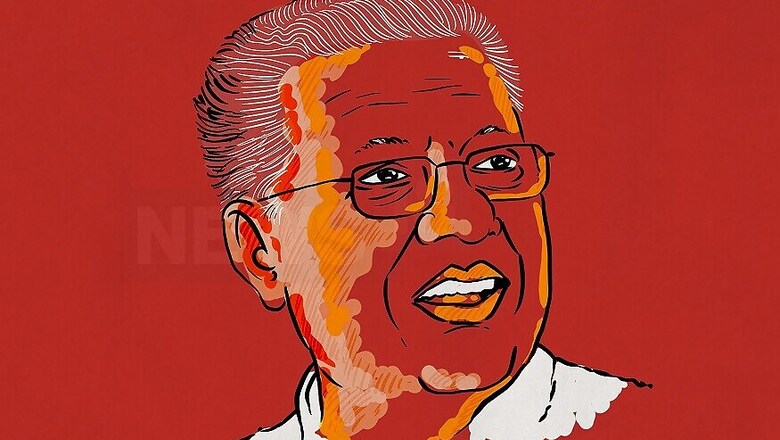
views
The controversy over the entry of women of menstruating age into the Sabarimala temple last week has left literate Kerala on the edge.
Chief Minister Pinarayi Vijayan, a dyed-in-the-wool Communist, who has been doggedly fighting communalism and the RSS, has ironically emerged a polarising figure himself after the Supreme Court’s Sabrimala verdict allowing women’s entry into the shrine.
It must, however, be said to his credit that he vowed to uphold the law and called the BJP’s bluff, facilitating the entry of two women below 50 into the forbidden temple on January 2, marking a milestone in gender equality. Their earlier attempts were foiled by members of radical Hindu outfits.
However, critics say Vijayan has walked into the BJP’s trap and helped further its divisive agenda. On the other hand, his supporters claim that he put the Congress in a Catch-22 situation and neutralised the BJP’s bid to polarise the state. On January 1, he mobilised all anti-BJP social forces under the aegis of the historic, 50 lakh+ women’s wall demanding gender equality that took the sting out of the BJP’s claim that the popular mood was against women’s entry into the temple.
The doughty Marxist, trying to emerge a “renaissance” leader and 21st century social reformer, has billed the women’s wall as a fight for “renaissance values”. In early December, addressing a local party function, he said: “There is an attempt to take the state back to the 18th century. We need to go forward. The values of renaissance should be protected. We will not allow the state to slide back and become a lunatic asylum”.
It was Swami Vivekananda who first called Kerala a “lunatic asylum” in 1892 after witnessing rampant casteism in the state; he himself was denied entry into the ancient Bhagavathi Kali temple in Trichur.
However, even secular sceptics term the women wall a “political gimmick”. A progressive CPM member, who did not want to be quoted, felt that the BJP is gaining support due to the initial mishandling of the issue. Vijayan, he said, unwittingly allowed the BJP to set the agenda. Some hardboiled Marxists feel that the CM should have kept the anti-Modi narrative on livelihood issues alive rather than harping on subjective themes like “renaissance” that may not connect with the millennial voters.
The Modi government is reeling under severe governance deficit and Sabarimala (like Ayodhya and cow worship) is part of BJP’s diversionary tactics. “The need of the hour is not renaissance but pinning the fascist BJP down on livelihood issues -- slump in economy, corruption issues in the wake of Rafale controversy, agrarian distress, bank NPAs, job losses. That narrative has been obscured by the handling of Sabarimala controversy,” said a CPM insider from Kerala, citing the recent electoral success of the Congress in Rajasthan, Madhya Pradesh and Chhattisgarh where it aggressively flagged bread-and-butter issues “without walking into Sangh Parivar’s divisive trap”.
Party leaders critical of Vijayan say he should have focussed on “political economy”, rather than getting sucked into the BJP’s “cultural nationalism” narrative. A service sector society like Kerala is staring at gloomy prospects with stagnating agricultural and industrial production, lakhs returning from Gulf countries looking for jobs (thanks to crisis in oil economy) and frequent hartals and shutdowns hitting tourism economy -- issues that will impact the election than renaissance.
Nevertheless, Vijayan’s tough handling of the temple issue has undoubtedly endeared him to a large section of people. Some compare Vijayan (74), a muscular Marxist, to PM Narendra Modi. Pro-business (by Communist standards), wears caste on his sleeves, confident and ruthless betraying a dictatorial streak -- traits that enabled him to rise through the ranks of the party faster than any of his peers.
Half-a-century ago, at just 23, he was appointed district committee member and two years later given ticket to contest the 1970 assembly elections. He was elected to the House five times and became the longest serving state secretary (17 years) till he was anointed CM in May 2016.
Hailing from a poor, backward Ezhava caste, he struggled to complete his graduation, working as a handloom weaver after school to supplement his father’s meagre income as a toddy tapper (who climbs coconut trees to extract liquor).
In October last year, an upper caste woman made casteist slurs against him for his Sabarimala stand. Recently, a derogatory cartoon caption in a BJP-sponsored Malayalam daily said: “This is what will happen if power is given to someone who should climb coconut trees.” And Vijayan promptly seized the insult to burnish his support base among the Ezhavas.
On Thursday, talking to local mediapersons, he said: “Some people remind me of my caste quite often... I am the son of a toddy tapper. And they believe that Vijayan should also be a toddy tapper.”
Kerala Congress chief Mullappally Ramachandran retorted, accusing him of “trying to divide the Hindu vote bank by sending the upper castes to the BJP fold”.
Though caste politics has no room in Marxist ideology, even his political adversaries in private compliment him for “neutralising” BJP’s communal polarisation through casteism, a la VP Singh, who used the OBC card, piggybacking Mandal Commission recommendations to puncture BJP’s Hindutva politics in early 90s. It took the BJP over two decades to neutralise Mandal with Kamandal.
However, some party men are not sure if the CPM gains from the stand-off. “What if a stung BJP transfers its votes (from constituencies where it is not strong) to the Congress only to teach the Marxists a lesson?” asked a worried comrade, adding, “In doing caste and communal politics, we cannot match the BJP and the Congress.”
The Lok Sabha election results will tell if Vijayan’s gamble will pay off or the BJP will break its Kerala jinx.
(The author is a senior journalist and political commentator. Views are personal.)




















Comments
0 comment